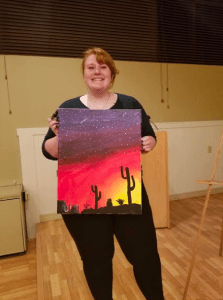
Feb 15, 2019 | News |
By Madison Lecowitch Contributing Writer

UMF Senior Juliana Burch is the host of Paint Night. (Photo courtesy of Juliana Burch)
The Center for Student Involvement at UMF will be holding monthly Paint Nights in The Landing to promote creativity, inclusivity and community. Juliana Burch, a senior at UMF, is the host of paint night.
Burch’s job is to select a painting to recreate, and to show students how to paint it with step-by-step instructions. “I’ll go on the internet and I’ll look at paint night photos on google images to kinda see what people do, and I try to find one that I think would be fun and that I would want to have on my wall,” Burch said. “I try to pick one that I feel people would want to do that might help them to feel better.”
Burch is majoring in English, with a double minor in International and global studies and film studies. She explains that painting has alway been a passion of hers. “I’ve always really loved art,” Burch said. “It’s such a great way to shut off a part of your brain. The worrying and the anxiety and the stress and everything that college and life puts on you.”
Although Burch enjoys all things art, painting doesn’t come very easy for her. Burch is color blind, which affects her ability to see specific colors. “I was in a bit of an accident when I was younger in the garage, and it resulted in a minor explosion, and basically the way I see color now is I can see green fine, but I can’t see blue and yellow,” Burch said. “Blue and yellow kind of blend in to green, so where everyone can see the green spectrum, the blue spectrum and the yellow spectrum, they’re all one long spectrum of green for me.”
Burch really tries to focus on making others happy. At the first Paint Night, students painted a sunset with cacti and shrubbery. “We’re in the middle of winter. It’s cold and it’s dark and it’s sad, so I wanted to do a sunset or sunrise because I feel those fill people with hope and happiness,” Burch said. “I thought that might be a nice way to warm people up with how cold winter is.”
Burch explained that Paint Night was formed to bring UMF together as a whole. “I’m a Community Assistant in the residence halls, and we host programs every semester to try and encourage kids to get out of their room and meet people and engage in, and kind of foster that sense of community that Farmington has,” Burch said.
Amethyst Leeman, a freshman, enjoyed the engaging community atmosphere that was created for Paint Night. “It was fun, and I liked hanging out with friends and seeing everyone’s finished product,” Leeman said. “I thought Juliana was fun, she really engaged the audience.”
The first paint night had about 24 attendees. Burch hopes that more people will show up for the next paint night. “I would love to try to make this a bigger event, especially if we have the funding for it,” Burch said. “I don’t want to turn people away from wanting to paint.”
In an email interview, Sydney Goodridge, a student on campus, explained that she chose to participate in Paint Night because it’s a creative outlet for beginning artists. “I participated in Paint Night because it seemed fun and simple enough for a novice,” Goodridge said. “I loved how Juliana created a pleasant atmosphere and easy-to-follow instructions.”
The next Paint Night will take place Monday, Feb. 25 at 8 p.m. Burch’s email is juliana.burch@maine.edu, and she encourages people to reach out to her for tips and suggestions on what they would like to paint next, or any music suggestions they have for the upcoming paint nights.
Nov 8, 2018 | News |
By Elina Shapiro Staff Reporter
As leaves begin to fall and birch trees become bare, UMF’s campus may start to look a little dreary, so Justin Cochran has an idea for how to brighten and unite the campus – a community graffiti wall.
Cochran, a first year transfer student and Secondary Science Education major, is hoping to work with administration to start up a graffiti wall somewhere on campus by spring 2019 where students, faculty, and staff could participate.
“It’s a constantly evolving message,” said Cochran. “Someone will have to paint over someone else’s work. It will eventually happen and I want people to feel encouraged and feel okay doing that, you know, because we want this to constantly evolve.”
Shawn Russell, an admissions counselor who introduces prospective students to the UMF campus, thinks that having a wall where everyone could participate would strengthen the UMF community.
“I think it’s really cool that it would be a collaboration between the staff and students,” said Russell. “It would be a really good way to show our students’ and staffs’ creativity that we have ‘cause sometimes it’s really hard to show that in a meaningful way.”
Cochran said that there would have to be a lot of discussion about what would be allowed, and what wouldn’t; and they hope to have a balanced committee to make these decisions. Ideally, the committee would be made up of students, staff, administration and people in facilities so all angles of campus would be represented.
Cochran is hoping that this wall will promote collaboration even when controversial topics come up. “I think the thing is that we have to make sure that when something decisive comes up that we turn it into a conversation,” said Cochran. “We don’t try to quell the conversation, we try to steer the conversation in a healthy direction.”
Gustavo Aguilar, Associate Professor of Experimental Performance and Art Division Chair, thought a committee would be a good idea to decide what is allowed and what will be taken down.
“There’s that fine line between hate and censorship, when someone crosses that line,” said Aguilar. “We always have to be aware of the fine spaces so we don’t become stuck into an ideology of what’s right or wrong but actually be able to have those debates, which is really what freedom is about, to be able to have those debates.”
With that in mind, however, Cochran said that there would be some guidelines. “To start, you let it be a place. You let it be a graffiti space. You remind students that this is part of college property so any sort of college rules apply,” said Cochran. “There are certain things as our school dictates, we can’t put up, but that doesn’t limit everybody’s creativity; it just reins it in a little bit to make it a nicer thing for everybody.”
Cochran hopes that this graffiti wall might lift some spirits as the ground turns white and temperatures drop. “Right now the campus looks beautiful and that’s great; we have fall; we have leaves changing; it’s so colorful right now,” said Cochran. “But looking at winter coming up, we’re not going to have any color, it’s going to be red brick buildings, white buildings, and snow, and that’s entirely boring and it’s just drudgery to have to walk past that every day.”
Russell also agrees that the graffiti wall would be especially beneficial to the community in the winter. “I think it would be a really positive thing, especially in the winter time, when you know, students are huddled up in their dorm rooms,” said Russell, looking out the window at the pouring rain. “…They could go down there and…do whatever they want with the graffiti wall and make something fun out of it, it would be a good time for those kids who maybe aren’t involved in winter sports or aren’t involved in athletics.”
This idea is still in its beginning stages, and in the coming weeks, Cochran will be talking to more professors, and people in administration about this possible plan. For now, they have a change.org petition to get support for this wall, which has over 30 supporters. The link for the petition is: https://www.change.org/p/university-of-maine-farmington-get-umf-administration-to-allow-a-graffiti-wall-on-campus
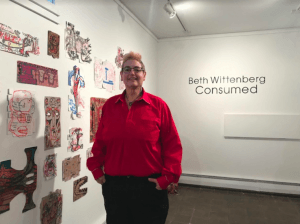
Nov 8, 2018 | News |
By Elina Shapiro Staff Reporter

Beth Wittenberg utilized trash and cardboard boxes to create the pieces in “Consumed” (Photo by Elina Shapiro)
“Consumed” is an exhibit currently on display until November 30th at the UMF Art Gallery, which includes a year’s worth of used cardboard boxes posted to the walls – each one covered with a unique drawing and strong language, sculptures made from trash materials found on the street, as well as a paintings covering two walls that Beth Wittenberg, the featured artist, made in less than 24 hours while setting up her exhibit.
Students and community members slowly circled around the art gallery during Wittenberg’s opening night, stopping at each piece while enjoying small snacks, and pausing to talk with Wittenberg who made herself available to anyone who wanted to meet her and discuss her artwork.
The attendees greatly enjoyed her unique style. “I feel like the majority of adults have squashed their childlike instinct to just paint whatever, and not really worry about it and obviously this has meaning, she’s not worried about being judged, because it is more of an abstract, childish form of art, but it is so like, impactful,” said Madee Curtin, a junior in High School. “I just want to go back and draw whatever and not worry about it being super good, I feel so happy right now, looking at this honestly, I haven’t seen art like this in a long time.”

Wittenberg combined trash with strong language to comment on consumerism. (Photo by Elina Shapiro)
Wittenberg said that she doesn’t have a plan, she just sits down and sees what happens. “I don’t get strokes of inspiration,” she said. “…It’s a spiritual consent thing, I don’t believe I am actually in charge of any of it. I feel like it’s divinely inspired.”
Wittenberg also said that things in her subconscious are visible in her pieces. “Whatever I am talking about in the day, it comes out in the art,” she said. “If I have an interaction with somebody, it’s all part of the whole dialogue.”
“Consumed” is an intriguing exhibit, as Whittenberg says it has a double meaning to it. “The show is called “Consumed,” to me I call it my ‘consumerism project,” but the individual pieces all together are called ‘throw-away people,’ they include the sculptures, they’re all made from things that were thrown away and it’s ‘throw-away people’ because people are often not cared for, similar to the way we take care of our trash,” said Wittenberg.
Allex Reed, a junior Creative Writing major, was inspired by Wittenberg’s theme. “I really like this art style. I really like the sort of abstract, political structure, the commentary on the United States on consumption culture, on capitalism…” said Reed. “It’s all commentary. It’s really interesting, this sort of thing. I would love to get to the point where I can make commentary like this in my own writing.”
Wittenberg’s wife, Seri Potter, was also at the exhibit and was blown-away herself. “The depth of her knowledge is amazing,” she said. “I don’t think we’ve scratched more than the surface of her talent, I think there’s so much more there.” The Art Gallery is open Tuesday through

Mar 2, 2018 | Feature |
By Emily Thibodeau Contributing Writer
Artist and activist Katrina Majkut recently visited UMF’s Emery Art center to share her art that “explores social traditions and their impact on civil rights.”

Katrina Majkut utilizes the cross stitching method to accentuate the status and hard work of women in society. (Photos by Emily Thibodeau)
Majkut’s work is on display in the Mantor Library and can be found on the Mezzanine. The series is made up of birth control methods, as well as other products associated with feminism. This is part of a series Majkut has been working on since 2010.
Majkut specializes in cross stitching, a form of sewing in which X-shaped stitches are formed into a picture.
“Cross- stitch is considered a low-end art, which is an unfair stereotype in contemporary art,” Majkut said.
Majkut was picked out of over 40 applicants from to be part of the “Art on Campus” program. Ann Bartges, chair of The Art on Campus Program committee said Majkut was unanimously chosen by the
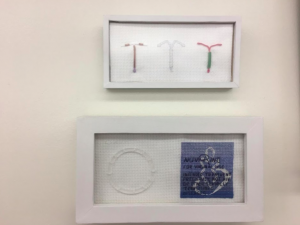
IUDs and a NuvaRing.
committee as “she does not try to get a specific response, but her goal is to get the conversation going,” as well as the fact that she can publicize “something such as a tampon in her art.”
Majkut got into cross-stit
ching when her mother taught her around age eight because “she was teaching me a part of my Ukrainian heritage.” Part of Majkut’s heritage is to learn skills to run a household at a young age.
“Those roles are extremely physical,” Majkut emphasised. Majkut uses cross stitch as a comparison and to representative to the physical labor expected from women.
Majkut has spent hours, even years working on each cross stitch piece. Majkut’s goal is to be “Intersectionally and medically honest” with her work, adding that, “if I don’t understand an object [medically] I refer to [Doctors].”
One piece discussed in the art talk was a Rape/ Sexual Assault kit cross stitch. “The rape kit opened up my eyes to how violent the process [of filing a report] is,” Majkut said. “I think this is the work that is just a response to who I am as an artist and person.”
A question from the audience was if Majkut had any advice for upcomin
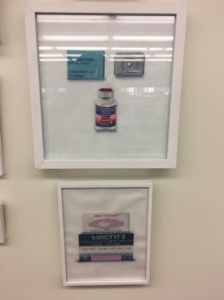
A pregnancy test and birth control. Majkut strives for medical honesty and accuracy.
g graduate art majors. Majkut said to “create a defined schedule for art, block time, start to build an art resume now, get used to talking to people. Rejection is high in this field and the art world is a numbers game.”
Avery Boucher, a freshman at UMF, attended the talk as a requirement for a digital imaging class. Boucher commented, “I think what she is doing is definitely new and different. I think as a feminist she has quite a unique way of expressing herself.”
After her talk, Majkut held a workshop where students could learn how to cross stitch. Bartges said, “Students were surprised by how long it takes” to create a cross-stitch pattern. This gave students an idea on how much work and labor is put into each cross stitch piece.
Majkut has recently written a book called The Adventures and Discoveries of a Feminist Bride: What no one tells you before you say ‘I do’. Majkut’s goal with this book was to “create dialogue around what it mean to be a woman.” The book invites readers to join Majkut’s personal journey through experiences with weddings and opinions on wedding traditions.
For more information on Katrina Majkut, please visit katrinamajkut.com.
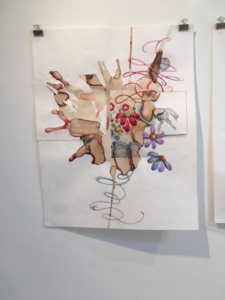
Feb 16, 2018 | Exclusive |
By Nicole Stewart, Staff Reporter
UMF Division of the Arts is featuring the exhibition “Rough Drafts,” a special art event dedicated to show off art from all of the UMF Art faculty.
The professors featured in the show include Ann Bartges, Tom Jessen, Dawn Nye, Elizabeth Olbert, Jesse Potts, Katrazyna Randall, and Barbara Sullivan. The show offers multiple forms of art, ranging from sculptures, drawings, paintings, and animations. The show is a way to bring the community together to see what the different art styles that th

Nye utilizes color among other techniques to depict subtle differences in society (Photo by Eryn Finnegan)
e Art faculty have, as well as offer different perspectives of the modern world
Dawn Nye, one of the professors involved with “Rough Drafts,” has her artwork on display. In an email interview, Nye reflected on favorite parts of the gallery. “I think this exhibit shows the diversity in our faculty, which makes me proud,” said Nye. “We are such a small institution, and we’re lucky to have such great people teaching here.”
Nye has two different pieces in the UMF Gallery. “The first is an animation called ‘Daydream Narcolepsy.’ This short deals with ideas of escape and distraction. The second piece is a hand painted woodblock series called ‘Public.’ This piece deals with divisions in our society–though not in a direct way,” Nye said.
According to Nye, the preparation began a few weeks prior to the opening. The Art department have been working to set up in the Flex Space and UMF Art Gallery. Nye mentioned how the gallery also helps the professors who are involved. “All of our faculty are working artists. Exhibiting and working in studio not only help us to develop our careers, it also helps us to become better teachers.”
The professors worked hard to complete this project, and Nye noted her favorite pieces among the others who are involved with the gallery. “One of my favorite moments is in the Flex Space at the Emery Arts Center, where Jesse Potts’ and Katrazyna Randall’s pieces are in view together. They have such different aesthetics, but somehow they seem to connect to each other,” said Nye.
On opening night, both

Jesse Potts’s Arc and Katrazyna Randall’s piece interact in subtle ways in the Flex Space
(Photo by Eryn Finnegan)
UMF students and the general public came to the show. The gallery had a wide arrangement of displays from projections to sculptures on the wall. The entire studio was filled from the first floor to the second floor in the art gallery on campus. In Emery, the displays featured portraits and sculptures done by the faculty involved.
For those who are interested, Rough Drafts is being presented in Emery Community Arts Center Flex Space and the Art Gallery. The show is open on Tuesdays through Sundays from 12PM-4PM until March 9th. Students and faculty can visit the website at artgalleryumf.org.







